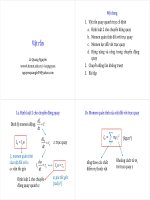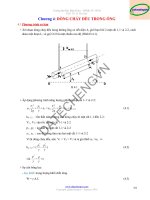Giao trinh bai tap 41 kts thi đáp án
Bạn đang xem bản rút gọn của tài liệu. Xem và tải ngay bản đầy đủ của tài liệu tại đây (183.08 KB, 79 trang )
ECE 307 – Techniques for Engineering
Decisions
Probability Distributions
George Gross
Department of Electrical and Computer Engineering
University of Illinois at Urbana-Champaign
© 2006 – 2009 George Gross, University of Illinois at Urbana-Champaign, All Rights Reserved.
1
OUTLINE OF DISTRIBUTION
REVIEWED
Discrete
Binomial
Poisson
Continuous
Exponential
Normal
© 2006 – 2009 George Gross, University of Illinois at Urbana-Champaign, All Rights Reserved.
2
THE BINOMIAL DISTRIBUTION
Binomial distributions are used to describe
events with only two possible outcomes
Basic requirements are
dichotomous outcomes: uncertain events occur
in a sequence with each event having one of
two possible outcomes such as
© 2006 – 2009 George Gross, University of Illinois at Urbana-Champaign, All Rights Reserved.
3
THE BINOMIAL DISTRIBUTION
success/failure, correct/incorrect, on/off or
true/false
constant probability : each event has the same
probability of success
independence: the outcome of each event is
independent of the outcomes of any other
event
© 2006 – 2009 George Gross, University of Illinois at Urbana-Champaign, All Rights Reserved.
4
BINOMIAL DISTRIBUTION EXAMPLE
We consider a group of n identical machines with
each machine having one of two states:
P {machine is on} = p
P {machine is off } = q = 1 − p
For concreteness, we set n = 8 and define for
i = 1, 2, … , 8, the r.v. s
© 2006 – 2009 George Gross, University of Illinois at Urbana-Champaign, All Rights Reserved.
5
BINOMIAL DISTRIBUTION EXAMPLE
⎧⎪ 1
Xi =⎨
⎪⎩ 0
machine i is on with prob.
p
machine i is off with prob. q = 1 − p
The probability that 3 or more machines are on is
determined by evaluating
⎧n
⎫
P ⎨∑ X i ≥ 3 ⎬ = P {3 or more machines are on}
⎩ i =1
⎭
© 2006 – 2009 George Gross, University of Illinois at Urbana-Champaign, All Rights Reserved.
6
BINOMIAL DISTRIBUTION EXAMPLE
= P {3 machines are on} +
P {4 machines are on} +
+
...
P {8 machines are on}
⎧n
⎫
P ⎨∑ X i ≥ 3 ⎬ =
⎩ i =1
⎭
8
8!
∑ ( 8 − r ) !r!
p
r
(1 − p )
8− r
r=3
© 2006 – 2009 George Gross, University of Illinois at Urbana-Champaign, All Rights Reserved.
7
THE BINOMIAL DISTRIBUTION
In general, for a r.v. R with dichotomous
outcomes of success and failure, the probability
of r successes in n trials is
P { R = r in n trials with probability of success p}
n!
n−r
r
=
p (1 − p )
(n − r ) !r !
the binomial
distribution
© 2006 – 2009 George Gross, University of Illinois at Urbana-Champaign, All Rights Reserved.
8
THE BINOMIAL DISTRIBUTION
We can show that:
E { R} = np
var { R} = np ( 1 − p )
⎧n
⎫
P ⎨∑ X i ≥ k ⎬ =
⎩ i =1
⎭
n
n!
∑ ( n − r ) !r! p (1 − p )
r
n-r
r =k
© 2006 – 2009 George Gross, University of Illinois at Urbana-Champaign, All Rights Reserved.
9
EXAMPLE: SOFT PRETZELS
Pretzel entrepreneur can sell pretzels at $ 0.50 per
unit with a market potential of 100,000 pretzels
within a year; there exists a competing product
and so we know he cannot sell that many
Basic model is binomial:
new pretzel is a hit
⇒
(success)
new pretzel is a flop
(flop)
captures 30% of
market in one year
⇒
captures 10% of
market in one year
© 2006 – 2009 George Gross, University of Illinois at Urbana-Champaign, All Rights Reserved.
10
EXAMPLE: SOFT PRETZELS
The probability of these two outcomes is equal
Market tests are conducted with 20 pretzels being
taste tested against the competition; the result is
that 5 out of 20 people prefer the new pretzel
We evaluate the conditional probability
P {new pretzel is a hit 5 out of 20 people prefer new pretzel }
© 2006 – 2009 George Gross, University of Illinois at Urbana-Champaign, All Rights Reserved.
11
EXAMPLE: SOFT PRETZELS
We define the success r.v.
⎧ 1
S = ⎨
⎩ 0
new pretzel is a hit
otherwise (a flop)
with
P { S = 1} = P { S = 0} = 0.5
and
Xi =
⎧
⎪
⎨
⎪⎩
1 person i prefers new pretzel
0 otherwise
We evaluate
P {new pretzel is a hit 5 out of 20 people prefer new pretzel }
© 2006 – 2009 George Gross, University of Illinois at Urbana-Champaign, All Rights Reserved.
12
EXAMPLE: SOFT PRETZELS
⎧
P ⎪⎨ S
⎪
⎩
20
= 1
∑Xi
i =1
P
P
⎧ 20
⎪⎪
⎨
⎪ i =1
⎪⎩
=
⎧ 20
⎪⎪
⎨
⎪ i =1
⎩⎪
⎫
⎪⎪
⎬
⎪
⎪⎭
∑ X i = 5 S =1
⎫
5⎪⎬
⎪
⎭
∑Xi
⎪⎧
⎨
⎪⎩
=
⎧
P ⎪⎨ S
⎪⎩
20
= 1 ,∑ X i =
i =1
⎧ 20
P ⎪⎨
⎪⎩ i =1
∑Xi
⎫
⎪⎪
⎬
⎪
⎭⎪
⎪⎧
⎨
⎪⎩
=
⎫
5⎪⎬
⎪⎭
⎫
5⎪⎬
⎪⎭
=
⎪⎫
⎬
⎪⎭
= 5 S =1 P S =1
⎪⎫
⎬
⎭⎪
P S =1 + P
⎧ 20
⎪⎪
⎨
⎪ i =1
⎪⎩
∑X
i
⎫
⎪⎪
⎬
⎪
⎪⎭
⎪⎧
⎨
⎩⎪
= 5 S =0 P S =0
© 2006 – 2009 George Gross, University of Illinois at Urbana-Champaign, All Rights Reserved.
⎪⎫
⎬
⎭⎪
13
EXAMPLE: SOFT PRETZELS
⎧⎪
P⎨
⎪⎩
20
∑Xi =5
i =1
⎫⎪
S =1⎬
⎪⎭
0.179 from the
binomial table
⎧⎪
P⎨
⎪⎩
20
∑X
i =1
i
=5
⎫⎪
S =0⎬
⎪⎭
is the binomial probability
that 5 out of 20 people prefer
the new pretzel with p = 0.3
is the binomial probability
that 5 out of 20 people prefer
0.0032 from the
binomial table
the new pretzel with p = 0.1
© 2006 – 2009 George Gross, University of Illinois at Urbana-Champaign, All Rights Reserved.
14
EXAMPLE: SOFT PRETZELS
Therefore,
P
P
⎧ 20
⎪⎪
⎨
⎪ i =1
⎩⎪
∑X
=
i
⎧ 20
⎪⎪
⎨
⎪ i =1
⎪⎩
⎫
⎪⎪
⎬
⎪
⎪⎭
⎫
⎪⎪
⎬
⎪
⎭⎪
⎧ 20
⎪⎪
⎨
⎪ i =1
⎩⎪
⎪⎧
⎪⎫
X
=
5
S
=1
P
S
=1
⎨
⎬
∑ i
⎪⎧
⎨
⎪⎩
⎪⎫
⎬
⎭⎪
= 5 S =1 P S =1 + P
⎪⎩
∑X
⎪⎭
i
⎫
⎪⎪
⎬
⎪
⎭⎪
⎪⎧
⎨
⎩⎪
=5 S =0 P S =0
⎪⎫
⎬
⎭⎪
(0.179)(0.5)
(0.179)(0.5) + (0.032)(0.5)
= 0.848
© 2006 – 2009 George Gross, University of Illinois at Urbana-Champaign, All Rights Reserved.
15
THE POISSON DISTRIBUTION
The binomial distribution is good for representing
successes in repeated trials
The Poisson distribution is appropriate for
representing specific events over time or space:
e.g., number of customers who are served by a
butcher in a meat market, or number of chips
judged unacceptable in a production run
© 2006 – 2009 George Gross, University of Illinois at Urbana-Champaign, All Rights Reserved.
16
REQUIREMENTS FOR A POISSON
DISTRIBUTION
Events can happen at any of a large number of
values within the range of measurement (time,
space, etc.) and possibly along a continuum
At a specific point z, P {an event at z} is very small
and so events do not happen too frequently
© 2006 – 2009 George Gross, University of Illinois at Urbana-Champaign, All Rights Reserved.
17
REQUIREMENTS FOR A POISSON
DISTRIBUTION
Each event is independent of any other event and
so
P {event at any point}
is fixed and independent of all other events
Average number of events over a unit of measure
is constant
© 2006 – 2009 George Gross, University of Illinois at Urbana-Champaign, All Rights Reserved.
18
THE POISSON DISTRIBUTED r.v.
.X is the r.v. representing the number of events
in a unit of measure
e − mmk
P { X = k} =
k!
E {X} = m
var { X } = m
m is the
Poisson distribution
parameter
Interpretation: the Poisson distribution parameter
is the mean or the variance of the distribution
© 2006 – 2009 George Gross, University of Illinois at Urbana-Champaign, All Rights Reserved.
19
EXAMPLE: POISSON DISTRIBUTION
Consider an assembly line for manufacturing a
particular product
1024 units are produced
based on past experience, a flawed product is
manufactured every 197 units and so, on
1024
average, there are that
≈ 5.2 flawed units
197
in the 1024 products are produced
© 2006 – 2009 George Gross, University of Illinois at Urbana-Champaign, All Rights Reserved.
20
EXAMPLE: POISSON DISTRIBUTION
Note that the Poisson conditions are satisfied
the sample has 1024 units
there are only a few flawed units in the 1024
sample
the probability of a flawed unit is small
each flawed unit is independent of every other
flawed unit
© 2006 – 2009 George Gross, University of Illinois at Urbana-Champaign, All Rights Reserved.
21
EXAMPLE: POISSON DISTRIBUTION
Poisson distribution is appropriate represen–
tation with m = 5.2 and so,
P { X = k} =
e
− 5.2
( 5.2 )
k
k!
If we want to determine the probability of 4 or
more flawed units, we compute
© 2006 – 2009 George Gross, University of Illinois at Urbana-Champaign, All Rights Reserved.
22
EXAMPLE: POISSON DISTRIBUTION
P { X > 4} = 1 − P { X ≤ 4} = 1 − 0.406 = 0.594
lookup Poisson table for k = 4, m = 5.2
The Poisson table states that
P { X ≤ 12} = 0.997
and therefore
P { X > 12} = 1 − P { X ≤ 12} = 0.003
© 2006 – 2009 George Gross, University of Illinois at Urbana-Champaign, All Rights Reserved.
23
EXAMPLE: SOFT PRETZELS
The pretzel enterprise is going well: several retail
outlets and a street vendor sell the pretzels
A vendor in a new location can sell, on average,
20 pretzels per hour; the vendor in an existing
location sells 8 pretzels per hour
© 2006 – 2009 George Gross, University of Illinois at Urbana-Champaign, All Rights Reserved.
24
EXAMPLE: SOFT PRETZELS
A decision is made to try to set up a second
street vendor at a different, new location
New location is considered to be
“good”
if 20 p/h are sold with probability 0.7
“bad”
if 10 p/h are sold with probability 0.2
“dismal” if 6 p/h are sold with probability 0.1
© 2006 – 2009 George Gross, University of Illinois at Urbana-Champaign, All Rights Reserved.
25









